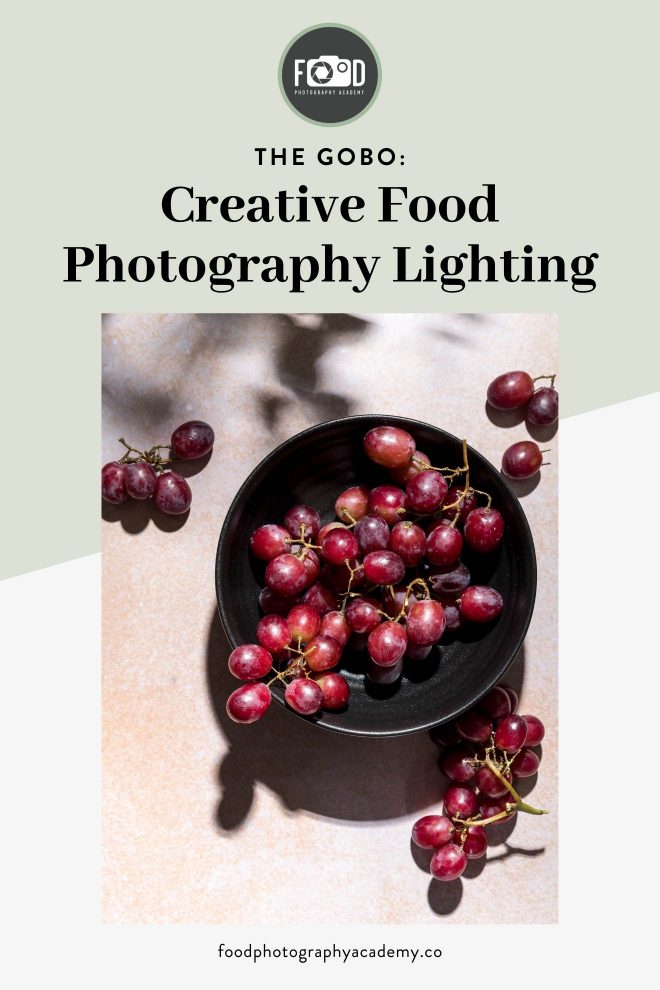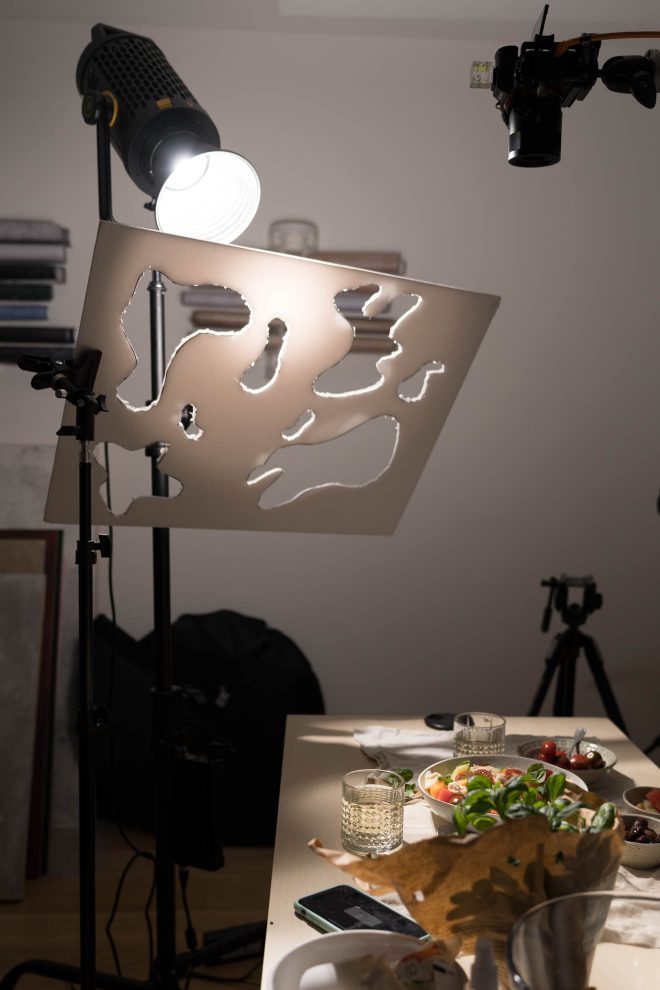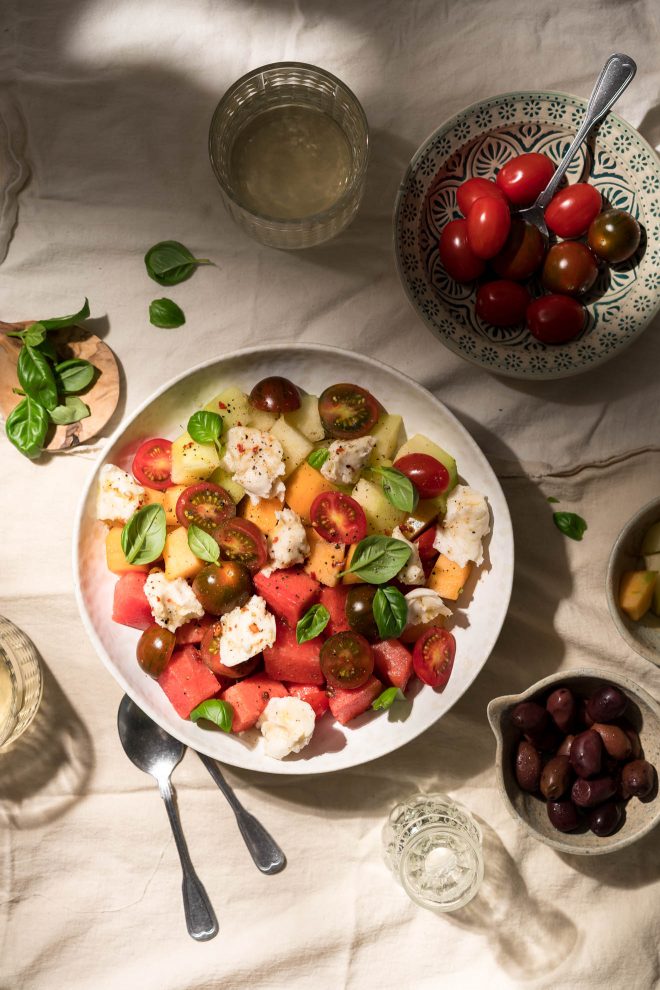Gobo lighting is a great way of spicing up food photography lighting. Even very simple items that you’ll already have around the house can make for excellent gobos.

Looking for creative inspiration? In this guide to DIY gobo lighting I run through a few of my favorite home-made gobo photography ideas that anyone can try out.
What Is a Gobo?
But just what is gobo lighting, I hear you ask? Well, for those who aren’t familiar with the concept, Gobo is short for “go between”, so a gobo is simply a method of adding interest to a lighting setup by placing an object between a light source and whatever you are photographing.
But why would you want to throw shadows on your subject? Well, aside from the fact that gobo lighting can simply look great, light is also one important way that we humans “read” our environment. In fact even people with no knowledge of – or indeed even interest in – photography will subconsciously register the signs created by light to understand important information about physical space.
For example, you don’t need to see a sunlit window to “know” that the window is there, just out of shot. The light coming through that window provides all the info you need.
Essentially, gobos are a method of storytelling with light. They suggest a whole world out of frame that the viewer can’t actually see, but can easily imagine when provided with the right visual prompts. Even if that world doesn’t actually exist. This makes gobo lighting a powerful creative weapon in the food photographer’s arsenal.
Controlling Gobo Lighting
While the results can be amazing, working with gobo lighting is surprisingly easy. And the only real technical challenge you’re likely to face is controlling the degree to which the shadows cast by your gobos are sharply focused.
Focusing gobo lighting works exactly like depth-of-field. Ignore the fact that depth-of-field is also influenced by lens focal length and aperture for a minute, and concentrate only on the difference that the relative position of the camera, subject, and background make to the sharpness of the background.
Remember that when a subject is close to the camera, but far from the background, the background will be relatively defocused? Similarly, put the subject far from the camera, and close to the background, and the background will be much sharper. It’s the same with gobo lighting. Only here the camera is the light source, the gobo is the subject, and the subject is the background.
Confused? No problem; just remember that a gobo placed close to the light source will cast a more blurry edged shadow, and far from the light source will cast sharply defined shadows. Easy. Now you can move your gobos around until you get the desired effect.

In this image, you can see that the shadows cast by the bowl and the grapes have hard, defined edges, that’s because they are far away from the light source and close to the background, but the shadows cast by the GOBO (in this case a plastic plant from IKEA!) are much softer, because the plant is closer to the light source and further away from the backdrop.
Want to know more about my continuous light setup? Download my free continuous light gear list below!
Gobos: Storytelling With Light
There are many commercially available gobos on the market. And you can even buy dedicated gobo projectors that allow you to focus and defocus the light. But in its most basic form, a gobo is just an object – any object – that partially blocks light. And, in the right hands, a gobo doesn’t need to be made in an especially complex or decorative shape in order to produce a stunning effect.
Again, the secret to gobo lighting is to think of it first and foremost as a narrative device. And it really doesn’t take a lot of equipment or imagination to begin storytelling with light. In fact, pretty much anything can work as a gobo, as long as it makes sense narratively and helps to reinforce the storytelling aspect of your photo.
First, then, think about the atmosphere you are trying to create in your shot. Is it a tropical salad to be enjoyed on a palm-fringed beach? Or a hearty soup to warm on a cold winter’s day? Once you’ve answered this question, you’ll have a clearer idea of the kind of gobo you should use to help create that story.
Related: My top 5 Food Styling Tips
In this image, I used a custom cut piece of foam core to create an “outdoors summer picnic” look, with mottled hard light.
#5 Awesome Low Cost DIY Gobo Lighting Ideas
Let’s take a look at some really simple DIY ideas you could try for gobo lighting.
Black Flag/Polyboard
The simplest gobos are just hard geometric shapes. They don’t do anything fancy; simply throw one part of the image into shadow while leaving the other half brightly illuminated.

Don’t be fooled by their simplicity though, as even very basic gobo lighting can totally transform an image. It’s all about how you position the gobo.
Use a black flag, studio polyboard, or piece of foam board to block the light from one or more areas of the shot. Now a flat, boring light source that looked like it was coming from a bare bulb in the same room suddenly seems like it’s shining in through an open doorway. In a single move, you’ve expanded the imaginary world just out of shot from a small room to an entire apartment.
GOBO Window frame
Cut a square or rectangular hole in a large sheet of foam board and use gaffer tape to attach a few pieces of stiff card or wood offcuts across the hole at equal intervals. The idea being to create the shape of a window frame. Now experiment with the distance and angle of the light to recreate whatever atmosphere fits your shot. Alternatively you can purchase a low cost window frame to achieve the same effect.

As an alternative, some people like to tape cross sections of wood to a picture frame. This can work too. But only if you will be shooting very close up and don’t mind all the light spilling around the sides of the frame. For wider shots, though, it will look totally unrealistic; like the sun is shining through a window that’s not attached to a wall!
I used continuous light to capture this shot, check out my gear list below!
Venetian Blinds
For a classic Film Noir vibe, nothing beats Venetian blinds placed in front of a hard light source. Hang them from a crossbar on a C-stand, and then alter the distance to adjust the definition of the shadows.

You needn’t be going for a sinister or retro atmosphere for Venetian blinds to work as a gobo though. When combined with the right shooting surface and props, it’s an effect that can create a very slick and modern look. Think a marble and stainless steel kitchen.
Just as with the window frame gobo above, keep in mind that letting light spill around the outside of the blinds and onto your subject would create a totally improbable effect. Like the blinds are just floating in mid-air. If necessary, place a polyboard to one side of the blind so that it recreates the look of a wall blocking the light.
Plants
Plants are probably my all-time favourite item for gobo lighting. They don’t even need to be real; I shot the above image (of the red grapes) with a plastic plant from IKEA as the gobo!
With that said, using real plants opens up a whole variety of effects. In fact I’m always on the lookout for interesting shaped plants. From Monsteras to tree branches and palm fronds, there’s so much that can be done with leaves as gobos.
Even if they are heavily defocussed, and so aren’t recognisable as leaves or branches, the shadows created by plants can still look amazing. Good gobo lighting isn’t just about producing easily identifiable shadows anyway, but can often work really well when it just adds a subtle degree of interest to a shot. In this case, by creating the kind of dappled lighting you might expect to see coming through a window on a summer’s day.
You can also create this effect by custom cutting some shapes out of a piece of white foam core.
Custom Gobo Lighting
While you can use pretty much any object for gobo lighting – as long as it’s big enough to cast an interesting shadow – in some cases you may have a very specific effect in mind. And here the best solution will be to buy something specific that you can attach to your light source.

Typically these attach to a snoot attachment and project a large shape onto your scene which you can move to different distances depending on the size you require.
Don’t forget to grab my free continuous light gear list if you’re interested in recreating this setup at home!
Final Thoughts
Gobos are certainly a fun way to add character and interest to your lighting, as well as creating scenes that suggest a certain atmosphere. What are you excited to play around with?



Excellent!
Thank you Lauren, very helpfull!!
This is so cool Lauren – can you post more examples on your Insta page pls? In my very early attempts to try food photography in a natural environment, I tried everything to get rid of Gobos!
I love all the ideas at the end. I use my blinds quite a lot. I put my strobe outside my window to a shoot through 🙂 Another DIY is to use a cereal box to cut instead of a foam core board into a gobo.
I like how you explained how to get the different shadow types as well. This is something I’ve just played with and didn’t give it as much technical thought. So thanks for sharing that.
Thanks Lauren. I didn’t know anything about gobo lighting. This was very informative and I believe I can replicate this technique with your detailed tutorial.
Thank you for sharing. Something happened to the volume in the last few mins and I didn’t catch it all.
I wanted to ask if you use a laptop or desk top as the screen looks really big. Thank you